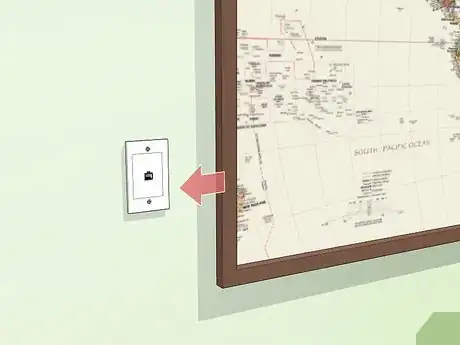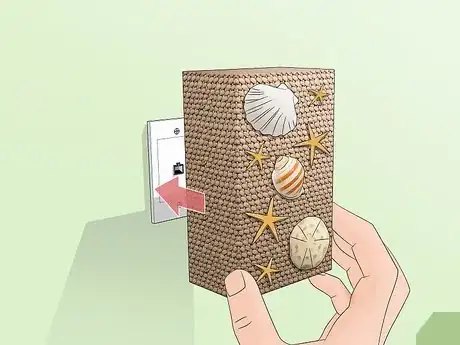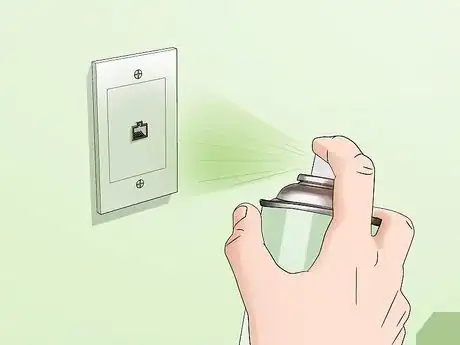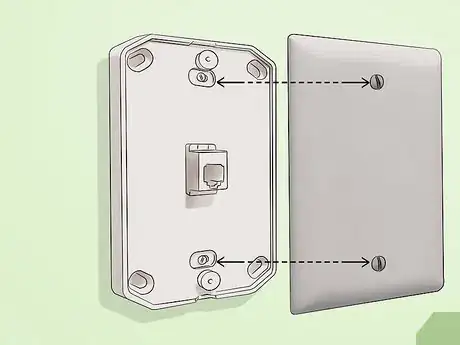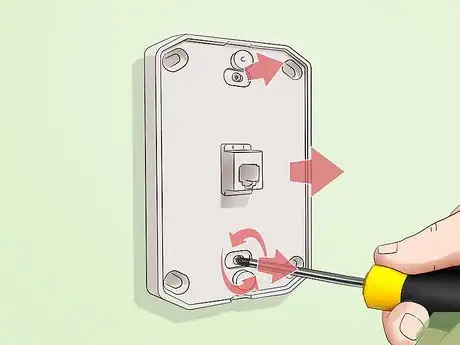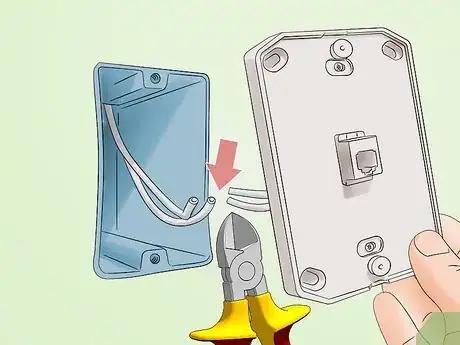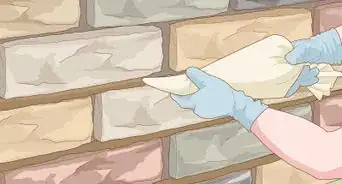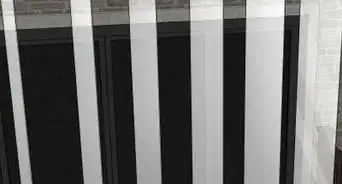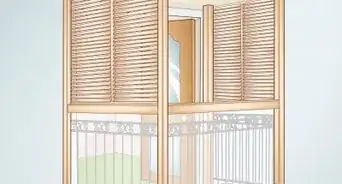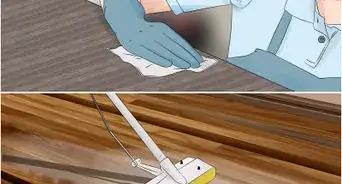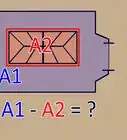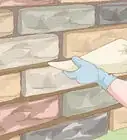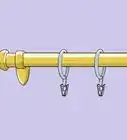This article was co-authored by Josh Goldenberg and by wikiHow staff writer, Eric McClure. Josh Goldenberg is a Residential Remodeling Expert and the Co-Founder of 5blox, based in the Greater Los Angeles area. With more than seven years of experience, Josh and his team specialize in luxurious and sustainable home renovations. 5blox is fully licensed and bonded.
There are 10 references cited in this article, which can be found at the bottom of the page.
This article has been viewed 114,411 times.
Nearly everybody has a cell phone these days, and you likely don’t need a landline unless you’re running or business out of your home.[1] Unfortunately, the odds are high that there are a few unused phone jacks built into the walls of your home. If you don’t plan on getting a landline, there’s really no need to keep these unsightly fixtures visible. Covering an old phone jack is simple, and hiding or replacing the jack can really contribute to a neater-looking room.
Steps
Using a Disguise
-
1Put a piece of furniture in front of the jack to hide it easily. You can reorient your room so that a sofa or desk is sitting against the wall with the phone jack, or get a small end table to place in front of it. This is the simplest way to cover up an unused phone jack.
- This is the easiest option if your phone jack is near the floor.
- If the phone jack is higher up on the wall, you may be able to place a tall bookshelf or armoire in front of it depending on which room the jack is in.
-
2Hang a painting or corkboard over the jack if it’s at eye level. Hammer a nail or stick a thumbtack into the wall a few inches above the jack. Then, hang the canvas or corkboard from the tack or nail to cover up the jack. Most phone jacks aren’t flush with the wall, so be sure to use a canvas or corkboard with a hollow space behind it.[2]
Tip: This isn’t really an option if the jack is closer to the floor. However, you can justify adding art on a lower portion of your wall if you create a gallery wall that is completely covered in art!
Advertisement -
3Create a custom piece of art to hang over a bulky phone jack. Get an old cigar box or hollow block of craft wood that is slightly bigger than your jack. Measure the dimension of the jack. Cut out a portion of the back of the box and slide it over the jack. Paint the box or attach pictures to it to convert the phone jack into a hook for a custom piece of art![3]
- This can be a really fun project if you enjoy crafts and creating art. It does take a little longer than the other options in this method, though.
- Most art or craft stores have a section filled with unpainted wood crafts, like hollowed out books, birdhouses, and small models. This is where you’ll find a hollow block of wood that will work for this.
-
4Paint over the jack if it’s flush with the wall to camouflage it. Get a can of paint that matches the color of your walls. Pour some of the paint into a paint tray. Use an angled brush to paint over the jack using smooth back-and-forth strokes. Continue painting over the jack until the color matches the rest of your wall.
- This won’t hide the jack entirely, but it will make it less likely to stand out.
- If you don’t have a leftover can of paint, pick up swatches from a local paint store and do your best to find a color that matches your walls.
Using a Flat Cover Plate
-
1Pry the cover off the faceplate with a screwdriver if no screws are visible. Inspect the faceplate for screws. If you don’t see any, you need to remove the cover so you can access the screws underneath it. Slide a flathead screwdriver between the wall and faceplate and apply a small amount of pressure to pop the cover off.[4]
- This is a best option if you don’t want to modify the way your room is set up or paint over anything. The flat cover plate is a much less conspicuous fixture than a phone jack, so it’s a good way to blend it into your wall.
- If your jack is really old or someone previously painted over the edge where the jack meets the wall, you may need to crack the cover to remove it. To do this, tap the side of the cover gently with a hammer or screwdriver until it cracks and then pull it off of the jack.
- A faceplate refers to any plastic or metal cover used to hold an outlet, light switch, or electrical box in place.
- Use a razor blade around the faceplate to cut the paint connection to ensure you don't do unnecessary damage to the paint.
-
2Purchase a flat cover plate that matches the screw slots on the jack. Count the number of screws on the phone jack and note their location. Measure the distances between them and jot the dimensions down. Go to any hardware or construction supply store and purchase a flat cover plate with identical screw slots. A flat cover plate is basically a flat piece of plastic or metal that is designed to cover up unnecessary outlets or jacks.[5]
- There are roughly 5-6 different patterns for faceplate screws, so you need to make sure that the cover plate matches the screw pattern on the jack.
- Flat cover plates typically come in beige, white, gray, black, metal, or brass.
-
3Unscrew the jack’s faceplate and pull it off of the wall by hand. Use a screwdriver to loosen the screws on the faceplate and remove them from the fixture. Then, simply lift the faceplate off. If the jack is really old or it sticks, slide a flathead screwdriver between the faceplate and the wall and pop it off. If there are wires attached to the faceplate, let it hang under your wall.[6]
- Do not rip the faceplate off if the faceplate has wires attached to it.
- If there are no wires, the landlord or previous homeowner disconnected the jack a long time ago and removed the wires without replacing the fixture. You can skip to the last step in this section if this is the case.
-
4Cut the wires off of the faceplate with rubber-grip wire cutters. Get a pair of rubber-grip wire cutters and trim an insulated portion of the wires where they connect to the faceplate to remove it. Even when a phone line is live, there’s very little electricity running through it and it won’t shock you, so this is about as safe as it gets when it comes to cutting wires.[7]
- Even if you flip the circuit breaker, the phone line will still have a current since landlines use a separate source of power. If you aren’t paying for a landline, the wires are already as dead as they can get.
Warning: Do not do this is if there’s a thunderstorm outside or you have a pacemaker. A thunderstorm can cause electrical wires to surge and shock you, and even a low volt of electricity may disrupt a pacemaker.
-
5Cap the wires with wire nuts and wrap them in electrical tape. On each wire, stick a small wire nut on top of the cut wire. Turn the wire nut clockwise while pressing down until you won’t turn it any further. Then, wrap each wire nut in enough electrical tape to secure it tightly to the wire it’s attached to.[8]
- While it’s probably safe to just tuck the wires inside the electrical box if they’re dead, it’s better to not take any chances.
- Wire nuts look like thimble-shaped pieces of plastic. They’re used to safely terminate live wires, but they can be used to cap off dead wires as well.
- You cannot use a different type of tape for this. Electrical tape is specifically designed to prevent wires from sparking and it won’t ignite if this happens.
-
6Stuff the wires inside the electrical box and attach your new cover plate. Bend the wires into the box so that they’re not sticking out past the wall. Then, unpack your flat cover plate and hold it over the electrical box so the screw slots on the box line up with the screw slots on the cover plate. Screw the new cover plate into place to finish replacing the jack with a sleeker fixture.[9]
Warnings
- Never cut wires if there’s a thunderstorm going on outside or you have a pacemaker. Lightning can cause electrical systems to surge, and even a small amount of electricity can disrupt a pacemaker or cause it to malfunction.[11]⧼thumbs_response⧽
Things You’ll Need
Obscuring the Phone Jack
- Nail
- Painting or corkboard
- Hollow craft wood
- Utility knife
- Paint
- Angle brush
Replacing the Jack with a Flat Cover Plate
- Screwdriver
- Flat cover plate
- Wire nuts
- Rubber-grip wirecutters
- Electrical tape
References
- ↑ https://www.businessinsider.com/death-of-the-landline-2013-12
- ↑ https://www.apartmenttherapy.com/10-clever-diy-projects-to-hide-household-eyesores-201984
- ↑ https://designertrapped.com/hide-phone-jack/
- ↑ https://youtu.be/9uI-lqNvnj8?t=2
- ↑ https://youtu.be/dEr055WyPp8?t=63
- ↑ https://youtu.be/3INc8AxLBPg?t=100
- ↑ https://todayshomeowner.com/replacing-a-telephone-jack/
- ↑ https://youtu.be/0ZXJ0C9O5sA?t=95
- ↑ https://youtu.be/3INc8AxLBPg?t=159

